 Fiji Golden
Islands Fiji Golden
Islands |
In 2003, Emperor Mine embarked on a three year capital
expansion programme requiring an additional investment
of $90m FJD (@ $45m USD). The Mine is calling this
the largest capital ever raised in Fiji since May
2000. $18m FJD (@ $9m USD) was raised through this
and an additional $32m FJD from a bank loan (@ $16m
USD). Striking a $2.5m FJD before tax profit in
2002 after six consecutive years of losses, Emperor
now wants to increase mine output by 40% to 800,000
tonnes and gold production by 35% to 180,000 ounces.
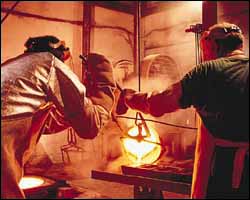
While bulk of the money will be used in its present
site at Vatukoula, Emperor also intends to pursue
explorations in three other sites in western Viti
Levu. The other strong potential for a gold mining
is at Mount Kasi on Fiji's second largest island
of Vanua Levu. Recently, Burdekin Pacific, owner
of Mount Kasi Mine intends to secure $4 million
(@ $ 2m USD) from issued notes to continue its drilling
programme in Fiji. Some investors though fear Fiji
has been over-explored for minerals, an assertion
the country's Mineral Resources
Minister, Ratu Naiqama Lalabalavu
denies. "Look at Vatukoula's Emperor
Gold Mine. They've been mining there for well over
67 years and each year their resource and reserves
still look good, we would like to see an emphasis
on industrial minerals, aggregates, sand, marble
and such. These are intensive explorations and have
an impact of wealth of the rural people".
Emperor Mining is Fiji's sole gold mine, having
been in the country the past 60 years when gold
was first discovered at a creek near its present
site in 1932. From 1933 to 1994, the goldfield produced
some 4.69 million ounces from 15.6 Mt of ore. In
2002, gold production totalled 131,175 ounces, 16%
more than the previous year. Mr. Harvie Probert,
Chairman of the Fiji Employers and Mining Council,
is one of the businessman in Fiji with exciting
prospects of gold. His company Geo Pacific, is currently
out looking across the western side of the Island
and assures in Fiji there is also an interesting
potential for gas or oil. Mr. Probert is also CEO
of Fiji Gas, an example of a successful joint-venture
between a Fiji and a foreign company, "something",
he says "can be seen when our growth goes
up over two times the Fiji GDP growth".
Fiji
Gas is the largest distributor of Gas in Fiji.

 Fiji Brand
Takes Fiji Water to the World Fiji Brand
Takes Fiji Water to the World |
It was in 2002 that Fiji's exports surpassed
the $1000 million FJD for the first time (@ $500m
USD). About $24 million FJD (@ $12m USD) of those
earnings came from the exports of Fiji Water,
bottled at source by Natural Waters of Viti. From
a company that only came into being in 1996, its
penetration of the US market has been nothing
less than spectacular. At one time, Fiji Water
was ranked number five as the most favourite mineral
water in the US, ahead of hundreds of others.
Lately, it has become the number two premium mineral
water consumed there, second only to the French
Evian. "This is no doubt the best success
story we have had over the years," says
Tomasi Vuetilovoni, Minister for Commerce, Business
Development & Investment. "It is marketed
mainly in the US and it has become the number
two premium mineral water consumed in the United
States. Evian of course has been around for over
a 100 years. So this is a huge success story and
Fiji Water is going to become one of Fiji's major
export earners".
Fiji's Minister for Mineral Resources Ratu Naiqama
Lalabalavu admits the speed in which Fiji Water
was accepted in the world market caught the country
by surprise. There is not even the necessary legislation
for the extraction of such a resource. "All
these are fairly new and this Ministry is tasked
to ensure that we come up with new policies and
legislation regarding underground water. For example,
there is still a need to come up with the legislation
to protect the interest of Fiji Water. This safeguards
the industry from aspects such as pollution or
over extraction".
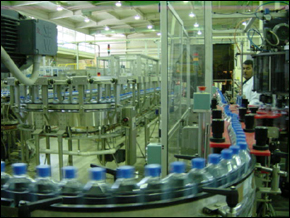
 Tap Into
The World's Largest Stock of Tuna Tap Into
The World's Largest Stock of Tuna |
Being an island nation, Fiji recognises the huge
potential of turning its fisheries industry into
a multi-million dollar industry. Exports of fresh
tuna are hovering at $50 million FJD (@ $25m USD)
in Fiji and other fish exports, fresh or processed,
make for a total of nearly $100 million FJD (@ $50m
USD). Says Prime
Minister Qarase: "Fisheries offer a
very high potential. The central and west Pacific
has got the largest stock of tuna at this point
in time in the world". Worried about reports
of over-fishing in other fishing waters, Qarase's
Government has limit the number of fishing licenses
it offers to local and foreign fishing companies.
Fiji is also studying the viability of reviving
its national fishing line. Almost $2 million FJD
has been set aside for the development of the country's
coastal fisheries and aquaculture (@ $1m USD).
|
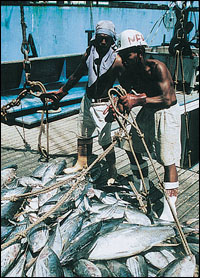
But it estimated the cost of flying an empty aircraft
back to Fiji would make outbound flights unviable.
Mr. Grahame Southwick, Executive Chairman of Fiji
Fish, declares that "there is no room
to increase production, it is time to start adding
value to our products. We have the fish and processing
companies can bring in their expertise to be part
of the future of the Pacific Tuna Fishing industry".
A recent study on Fiji's fisheries sector will see
the formation of a national fisheries authority
to spearhead commercial activities. "The
National Fisheries Corporation is going to spearhead
some of the major programmes and developments by
the government", explains Fisheries Minister,
Konisi Yabaki. "Asians are very good in
aquaculture development and right now we are looking
at marine research. We have recently started establishing
links with the university, especially the University
of Hawaii. We have been doing a lot of research
and we need to capitalize on this one. We need to
know our own capacity to make use of the data and
turn it into projects".
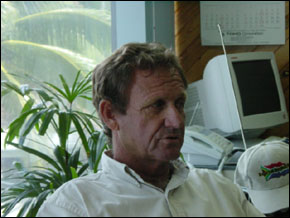
 Cannery
Links Up With World Food Manufacturer Cannery
Links Up With World Food Manufacturer |
A major player in the local fisheries sector
is Pacific Fishing Company, PAFCO for short, the
country's sole cannery based in Levuka, the old
capital of Fiji. Government owns 95.5 percent
of the cannery, although one of the largest United
States seafood businesses Bumble Bee will be offered
equity. PAFCO recently extended its supply agreement
with Bumble Bee, which sees the Fiji cannery exporting
tuna loins to the US-based company. Because of
the extension of the supply deal, PAFCO plans
to hire 200 more workers to boost production from
processing 230,000 tonnes of tuna to 300,000 tonnes.
"We know that there is a big market for tuna
in the United Kingdom and we will be looking at
working closely with one of the biggest food suppliers
there," says Mitieli Baleivanualala, PAFCO's
chief executive officer.
 Search
for Strategic Partner in Lucrative Mahogany
Timber Search
for Strategic Partner in Lucrative Mahogany
Timber |
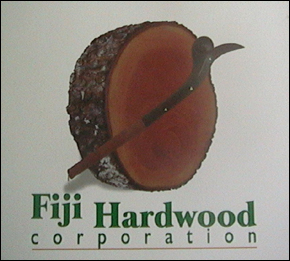
Mahogany is Fiji's most lucrative timber resource
with the country claiming to have the only mature
mahogany plantation in the world. With over 40,000
hectares of swietenia macrophylla, an exotic
mahogany species, spread out in 14 plantations,
Fiji's claim may not be far off from the truth.
The world's largest supplier of the lucrative
timber, Brazil, is also helping Fiji's case with
its decision to place a moratorium on the sale
of its mahogany. In 2001, timber exports grossed
$41.3 million FJD (@ $20.65m USD), but this is
expected to swell once the harvest and processing
of mahogany begins. For the time being, the Fiji
Hardwood Corporation Limited, a government company
established to manage its hardwood plantations,
is conducting harvesting and processing trials
on some matured trees.
The Fiji Government on the other hand will seek
out a strategic partner to manage the multi-million
dollar business. Landowners of the mahogany plantations
will also be made partners of the venture with government
promising to give them 10 percent of stumpage, 50
percent of profit and 100 percent in contracts.
The suggested pay out was contained in a study commissioned
by the government and is aimed at pacifying resource
owners. The actual value of the resource has been
a story in itself. One time interested harvester
and processor, the Commonwealth Development Corporation
of Britain valued Fiji's mahogany forests at $136
million FJD (@ $68m USD). Its rival, Timber Resources
Management of the United States, pegged its value
at $400 million FJD (@ $200m USD). If that was not
confusing enough, a Fiji government commissioned
New Zealand consultant came out with a valuation
of $150 million FJD (@ $75m USD). Fiji Hardwood
Corporation puts down the confusion in prices to
"commercial sensitivity". "Sensitive
in the sense that the figure varies depending in
whether they are being quoted by the buyer or seller,"
it says. The company's projected output is 100,000
cubic metres annually for the first 14 years, increasing
to 200,000 cubic metres in the next 16 years. "We
would like to start processing that and we hope
this will take off during the next twelve to eighteen
months," Prime Minister
Qarase tells World Investment News. "We
would like to have value adding to be done in Fiji
concerning this commodity. We will not allow the
selling of logs and we will process them here at
least into timber products. We believe we have the
incentives for investors to come and do further
downstream processing of timber turning it into
other forms of wood products". Fiji also
has a developed pine industry valued at $35 million
FJD (@ $17.5m USD) and a thriving export of pine
chips to Japan. |

